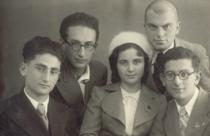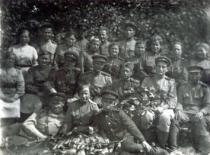This is me, Boris Molodetski (first from the left), in hospital with registrar Anfisa Kazantseva and patients. This photo was taken in Sarny, Rovno region in 1944.
During World War II, I and my mother evacuated to Alma-Ata (Kazakhstan). In Alma-Ata I went on my education in the Kazakh Medical College. On 3 July 1943 I received my diploma with honors and became a certified therapist. On the following day we received subpoenas to the military office.
We arrived at the front in Nezhin on 6 November 1943. We were following advancing troops to the West. Our hospital was near the railway station in Sarny, Rovno region. The station was continuously bombed and we moved to Tutovichi station in 8 km from Sarny. We lived in earth huts that our patients helped us to dig. In one earth hut women were accommodated and men in another. There were two couples living in a civil marriage: they had two small separate earth huts made for them. We built a barrack with a diner and a storeroom and also we made a club in a tent spread on two posts. There were swarms of mosquitoes exhausting us. They hummed exactly like German Heinkel aircraft. We set green spruce cones on fire in tins from American tinned meat: it generated acrid thick smoke. We installed it in the dwelling and when the smoke filled it one of us keeping his breath ran inside and grabbed the tin to take it outside. We hanged a gauze curtain on the door. This helped us to get rid of mosquitoes.
My department of slightly wounded patients was in a barrack. There were plank beds along the walls. In the corner we made a curtain for a bandage room. I had 200 patients almost all of them were wounded in their limbs. I developed a conveyer method that was approved at the military medical conference in Brest in 1944. The procedure was as follows: two patients came in and lay on a couch. A medical assistant removed dressing from one patient and a medical nurse started treatment of the wound and then they switched to another patient and the first one was ready for me. Working with his wound I dictated to senior nurse making records. Then the assistant applied bandage on the first patient and I switched to another one.
Attendants in the hospital washed bandages, but they took the rest of laundry to special laundry units. Many patients had fleas. I managed to escape this by changing my underwear every day. This was rough cheap cotton underwear and when you moved your shoulders it felt like a bast whisp brush. We often washed in the sanitary washroom. There were huge 500 L tubs connected to a boiler. Patients and hospital employees had meals in the dining room. We had good food. There was always a nice piece of meat in borsch or soup. This was our base food. We received uniforms in the storeroom. We chose a bigger size overcoat to have it altered by a tailor when we lodged in a town. Some women even managed to have puffed sleeves made in their coats. There was a shoemaker among our patients. He could make nice boots from a pair of hospital slippers and ground sheet. They were light and nice, although they were khaki color that was against the rules. We applied black shoe polish and managed to polish them to glitter and they looked as the best boxcalf boots.
When the 'Bagration' operation began, we had many patients arriving to the hospital. [Belarus operation of the Soviet army in the summer of 1944. The invasion force consisted of 1,700,000 troops supported by 6,000 planes, nearly 3,000 tanks, and 24,000 artillery pieces. This attack cost the Germans more men and material than the defeat at Stalingrad.] I was on duty when once they took a patient with a misfire 'frog'-mine that stuck between his chest and shoulder blade. I called chief surgeon, but he got scared and refused to help me. I cursed to myself and found a field engineer. His last name was Smirnov. He was slightly wounded. A medical nurse prepared two sets of surgical tools on two tables. I ordered the others to stay at least 50 m away from surgery tent. I asked this field engineer where I could make a cut and only when he said it was all right I moved my scalpel. When we removed the mine Smirnov placed it in a box with sand and soon I heard an explosion. For this surgery I was awarded a Red Star Order. Later I corresponded with that Tajik villager for five years.




















